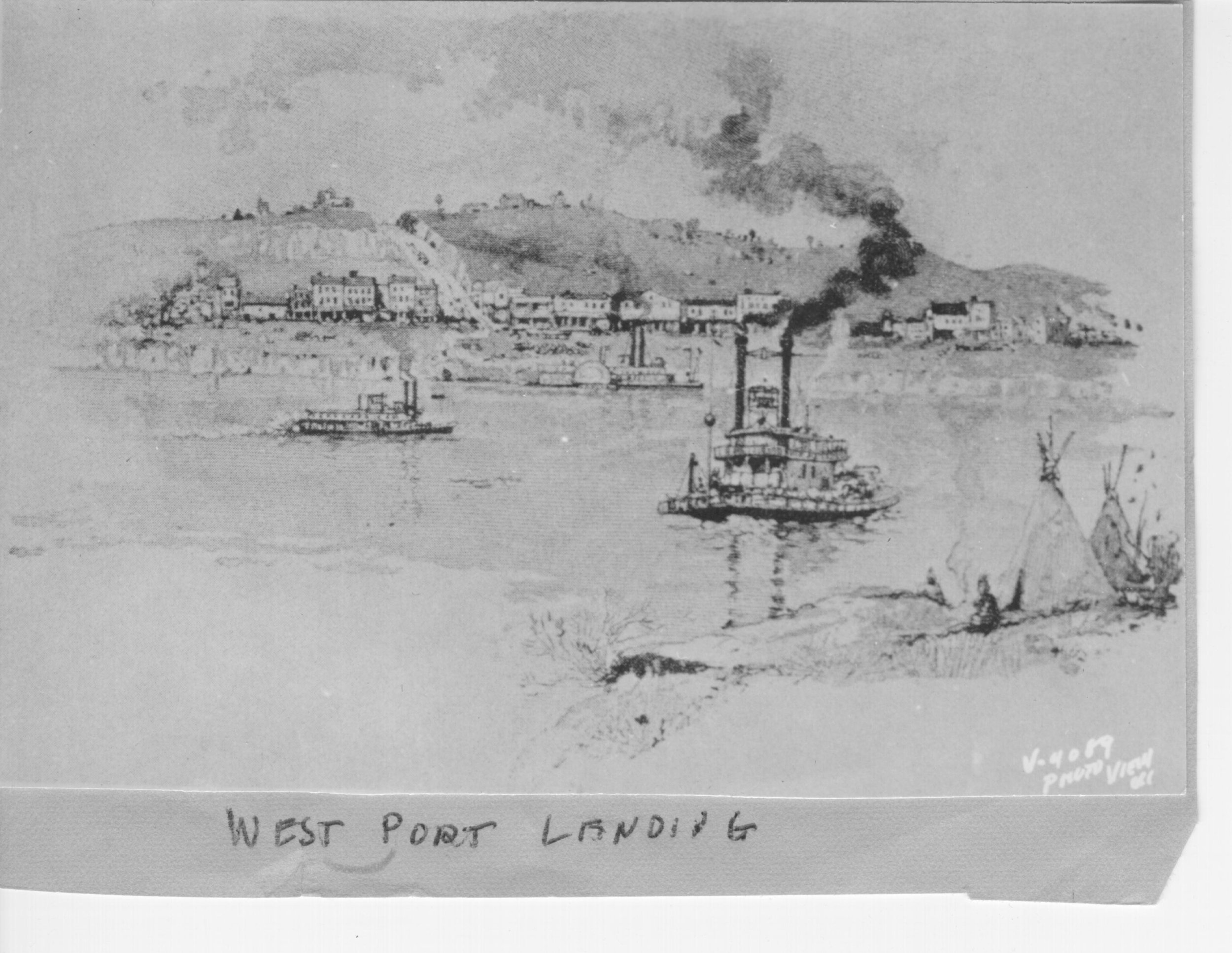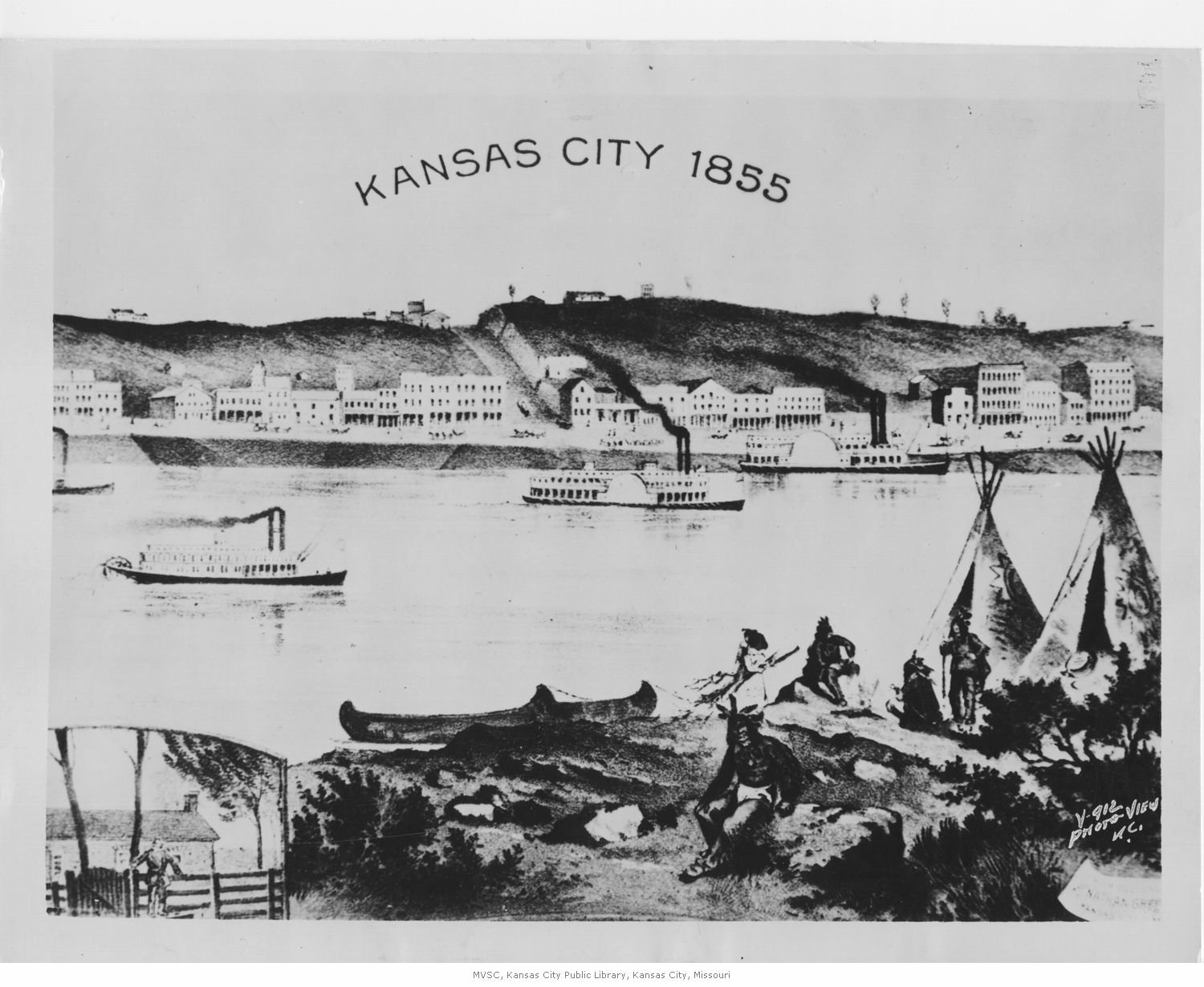UPDATES ADDED 2/12/24; 2/13/24; FULLY RESTORED 11/6/24
Now that the Super Bowl has played out, we can get into more of the details. This site will be updated as more is revealed.
Here we go, sports fans. Another Super Bowl, another half time. I wanted to post this today, before the game, so that you can have the full benefit of the information included here, while you watch the Game. If you watch the game.
If you follow my posts, you know how I work. I look for the deeper, hidden meanings of names, places, histories and locations.
I think this post includes all of those things. Please take it to heart. Do not turn away. This is revelation knowledge that will help you prepare for what is coming.
space
UPDATES ADDED 2/13/24
spacer
 Visit #EnchantedLifePath Website https://EnchantedLifePath.com
Visit #EnchantedLifePath Website https://EnchantedLifePath.com  New #EnchantedLifePath Podcasts On #Spotify And #ApplePodcast
New #EnchantedLifePath Podcasts On #Spotify And #ApplePodcast  How To PayPal Me: Please only tip me if you really want to as I am 100% with truth being free on ELP TV but thanks in advance if you do contribute to the platform #WeAreTheNews – https://www.paypal.com/paypalme/EnchantedLifePath
How To PayPal Me: Please only tip me if you really want to as I am 100% with truth being free on ELP TV but thanks in advance if you do contribute to the platform #WeAreTheNews – https://www.paypal.com/paypalme/EnchantedLifePath  Powered By #Restream https://restream.io/join/enchantedlifepath
Powered By #Restream https://restream.io/join/enchantedlifepath  US Amazon Influencer Store https://www.amazon.com/shop/influencer-78142c23
US Amazon Influencer Store https://www.amazon.com/shop/influencer-78142c23  UK Amazon Influencer Store https://www.amazon.co.uk/shop/influencer-78142c23
UK Amazon Influencer Store https://www.amazon.co.uk/shop/influencer-78142c23  New Enchanted LifePath Videos On Spotify – Watchable Video Podcasts https://open.spotify.com/show/3TNASsiWgrN7Fwzd6ozzdA
New Enchanted LifePath Videos On Spotify – Watchable Video Podcasts https://open.spotify.com/show/3TNASsiWgrN7Fwzd6ozzdA  Enchanted LifePath #Spotify Podcast – Audio only https://open.spotify.com/show/4DnlSd7yCF0Vbg0UpekOPf
Enchanted LifePath #Spotify Podcast – Audio only https://open.spotify.com/show/4DnlSd7yCF0Vbg0UpekOPf  Enchanted LifePath #ApplePodcast https://podcasts.apple.com/us/podcast/enchanted-lifepath-podcast/id1607354229 ELP TV CHANNELS and BACKUPS
Enchanted LifePath #ApplePodcast https://podcasts.apple.com/us/podcast/enchanted-lifepath-podcast/id1607354229 ELP TV CHANNELS and BACKUPS  Main #YouTube Channel https://www.youtube.com/channel/UCCgIpvJ6BoXfYXJbARR6yHQ
Main #YouTube Channel https://www.youtube.com/channel/UCCgIpvJ6BoXfYXJbARR6yHQ  ELP TV Membership: https://www.youtube.com/channel/UCCgIpvJ6BoXfYXJbARR6yHQ/join
ELP TV Membership: https://www.youtube.com/channel/UCCgIpvJ6BoXfYXJbARR6yHQ/join  Back-Up YouTube Channel – Enchanted LifePath TV https://www.youtube.com/channel/UCnDFhamsEE2po40KIlVQEpA
Back-Up YouTube Channel – Enchanted LifePath TV https://www.youtube.com/channel/UCnDFhamsEE2po40KIlVQEpA  Enchanted LifePath Podcast YouTube Channel https://www.youtube.com/channel/UCBHnjSY8vEtuZFAxx7cOgcw/
Enchanted LifePath Podcast YouTube Channel https://www.youtube.com/channel/UCBHnjSY8vEtuZFAxx7cOgcw/  Join Enchanted LifePath on #Odysee https://odysee.com/@EnchantedLifePath:8
Join Enchanted LifePath on #Odysee https://odysee.com/@EnchantedLifePath:8  #Bitchute: Enchanted LifePath Channel https://www.bitchute.co..
#Bitchute: Enchanted LifePath Channel https://www.bitchute.co..spacer

USHER ENTERS SEATED ON A CRYSTAL THRONE OF TETRAHEDRONS. HE IS DRESSED ALL IN WHITE, WITH A ROBE TO THE FLOOR. WHITE GLOVES.
As he is energized by the light that touches him, he begins to rise, and shake himself as if shaking something off.
 |
 |
 |
 |
AS HE DESCENDS THE TRHONE, THERE ARE WOMEN ON EITHER SIDE OF HIM< LITERALLY BENDING OVER BACKWARD.
We see a bunch of ladies in Blue with huge fluffy feather tails. Above them for just a flash appears the what demon looking thing overhead.
 In that same flash of a moment, a male leaps or is catapulted up into the air. While the demon is still above. As if it is the BEAST rising out of the sea.
In that same flash of a moment, a male leaps or is catapulted up into the air. While the demon is still above. As if it is the BEAST rising out of the sea.
 Here you see him in the air.
Here you see him in the air.
 And hear as he falls into the crowd of people, and falling with him are flashes of light. Perhaps fallen Angels?
And hear as he falls into the crowd of people, and falling with him are flashes of light. Perhaps fallen Angels?

There is chaos and confusion all over the stage. Bodies flying everywhere.
USHER MAKES A SIGNAL LIKE COME HERE and the ladies in blue with the feathery fans surround him. He is fully covered in blue feathers and as they pull away they frame his shoulder with the Phoenix broach.

 |
 |
It seems that they used the concealment to free the wings of the Phoenix. As Usher works his upper boy the wings of the Phoenix make a flapping movement.
 |
 |
spacer
Suddenly the CHAOS is resolved. Everyone is in step and they all bow in submission.

This thing caught my eye moving across the back of the stage, as they bowed. It is a man on stilts with the head of a BIG BIRD.

NOW THE FOCUS IS THE THRONE. EMITTING LIGHT AND SURROUNDED BY LIGHT.

ALICIA KEYS ENTERS UNDER A SHROUD OF BLOOD RED. AS THE SHROUD FLOATS AWAY, WE SEE HER SEATED AT A RED PIANO ON A BLUE CIRCLE. RED AND BLUE, USHER JOINS HER, DRESSED IN WHITE RED WHITE AND BLUE ARE NOT ONLY THE COLORS OF THE USA BUT OF BRITAIN AS WELL.
 |
 |
 |
 |

USHER IS JOINED BY WILL I AM (WILLIAM) DRESSED IN BLACK AND BLUE and the SONG?
SONG: OH MY GOD – OMG!
 WILL I AM @ THE SUPERBOWL HAFLTIME SHOW WITH USHER
WILL I AM @ THE SUPERBOWL HAFLTIME SHOW WITH USHER
spacer
spacer
Gabriella Sarmiento Wilson (born June 27, 1997), known professionally as H.E.R. (pronounced “her”, also an acronym for “Having Everything Revealed“) Source

Usher and H.E.R. perform at the Apple Music Super Bowl halftime show on Feb. 11 in Las Vegas. CHRISTOPHER POLK FOR BILLBOARD
Of Course it would not be the Super Bowl without the SUN WORSHIP CIRCLE. RING OF FIRE, FIRE OF LIFE, SUN AT THE CENTER AND USHER as the Symbol of the ANTI CHRIST AT THE CENTER.

spacer
UPDATES ADDED 2/12/24
If the lighting of the Torch is meant to honor both AL DAVIS and those chosen to light the Torch, why is that ceremony not presented on Television during the Super Bowl program?
|
|
spacer
spacer
spacer
allegiance (n.)
verb allege “to alleviate, lighten” (from Latin alleviare, from ad “to” + levis “light” in weight; from PIE root *legwh- “not heavy, having little weight”).

Allegiant Stadium
Allegiant Stadium is a domed multi-purpose stadium located in Paradise, Nevada, southwest of adjacent Las Vegas. Opened in 2020, it is the home field of the Las Vegas Raiders of the National Football League (NFL) and the University of Nevada, Las Vegas (UNLV) Rebels college football team. The stadium also hosts the Vegas Kickoff Classic in early September and the Las Vegas Bowl in December. The stadium will host Super Bowl LVIII in February 2024.
The venue is located on about 62 acres (0.25 km2) of land west of Mandalay Bay at Russell Road and Hacienda Avenue, between Polaris Avenue and Dean Martin Drive, just west of Interstate 15. At $1.9 billion, it is the second-most expensive stadium in the world. Taxpayers shouldered $750 million of the cost of construction.[12] Construction of the stadium began on November 13, 2017, and its certificate of occupancy was issued on July 31, 2020.[13]

|
“The Death Star”[1]
|
|

Allegiant Stadium in May 2021
|
|

|
spacer
link: https://www.tiktok.com/@architectrussell/video/7334216031688314118
Watch on TikTok
xpacer
spacer
The Super Bowl’s Allegiant Field features a roll-out field and looks like the Death Star
The stadium has other notable features, including a 92-foot-tall torch.

Las Vegas Raiders owner Mark Davis called his new home, the Death Star, in 2020—and the name stuck.
Allegiant Stadium, with its black facade, in fact resembles the ominous space station from the Star Wars franchise that was capable of destroying planets.
The futuristic stadium takes center stage on February 11 when the Kansas City Chiefs and San Francisco 49ers meet in the first-ever Super Bowl in Las Vegas.
spacer
raider (n.)
spacer

Commemorating the long-time franchise owner of the Las Vegas Raiders, the vision for the Al Davis Memorial Torch required an approach beyond traditional fabrication methods. With this challenge in mind, we proposed an unconventional idea: the torch, standing over nine stories tall, would become the world’s tallest free-standing 3D-printed structure.
DI worked closely with Mark Davis, current owner of the Raiders and son of Al Davis, along with other leaders from the organization to ensure the torch paid homage to the influential owner. In addition to the Raiders, we collaborated with MANICA Architecture, original conceptual designer of the torch; Mortenson-McCarthy, general contractor; HNTB, architect of record for Allegiant Stadium; Ultratech Aerospace; A. Zahner; Bob D. Campbell Engineering; Astound Group; and Purdue University in its design and creation. Eighteen DI employees have dedicated nearly 50,000 hours developing, creating and installing the structure.
|
226 3D-printed blocks made of carbon fiber, reinforced polycarbonate composite, each weighing approximately 350 pounds |
1,148 Unique surface aluminum panels make up the metallic surface of the torch—each robotically painted for a custom finish and seamless reflectivity |
In 2019, our team acquired a 5’ x 10’ x 20’ Large Scale Additive Manufacturing (LSAM) machine—one of three existing models created for large-scale 3D-printing in the United States—to begin the project. While other fabrication methods couldn’t recreate the torch’s unique shape with precision and minimal waste, the LSAM was going to make this complex project possible.
The Al Davis Memorial Torch is constructed of 226 3D-printed blocks made of carbon fiber, reinforced polycarbonate composite, each weighing approximately 350 lbs. Over 100,000 lbs. of raw material were used to print the blocks, which were then machined on a five-axis router to a tolerance of approximately the width of a human hair.
|
50,000 ( simplified this is 5 the number of death) Hours needed to develop, create and install the memorial |
93 FEET (9 = 3 3 3 – 3 or 9 +3 =12 = 4 x 3) The height of the torch, from base to tip |
spacer
spacer
Mark Davis reveals who will light torch at Allegiant Stadium for Super Bowl
New! Yardbarker on MSN
In Allegiant Stadium in Las Vegas, the stadium holds a giant torch that is “lit” by LED lights. It’s called the Al Davis Memorial Torch. Before every home game, someone lights it, and usually, it’s a former Raider or someone of significance to the history of the game or the history of the Raiders.
On Sunday, for the Super Bowl, they will also do it, but they will have some very special guests representing the Raiders doing it.
|
WillieGRamireZ
@WillieGRamirez
“This Sunday, we’ve got lighting the torch … 3 Raider #SuperBowl MVPs: Fred Biletnikoff, who’s White. Jim Plunkett, Hispanic. And Marcus Allen, who’s Black. The Raiders are diversity and our greatest players are diverse. … We’re very proud of it.” #Raiders owner Mark Davis.
|
The fact that the Raiders get to do that during the Super Bowl, where the world will be watching, is beyond cool, and I think a lot of Raiders fans who are upset about these two teams playing in their stadium will be happier when they see three of the greatest Raiders ever light the torch.
spacer
Las Vegas isn’t just a city, it’s constant entertainment brought to life by the neon lights. What better way to capitalize on its strengths than with the Super Bowl?
Entertainment, and the arts in general are a form of industry. Crafts taught by the fallen. Lights of course are from the devil.. Imitations of God’s light, used to deceive you and keep your mind to busy to focus on spiritual things and GOD’s TRUTH.
For the first time, Las Vegas is welcoming the biggest game in the country. Super Bowl 58 will be played at Allegiant Stadium, home of the Raiders, in February.
More importantly than the teams playing in the game, though, is who comes out at halftime. The Super Bowl halftime performer is arguably just as big as the football being played, and viewers excitedly look forward to the halftime show months ahead of time. The good performers put on a show, and the great performers make lasting impressions for years on end.
The Super Bowl kicks off at 6:30 p.m. ET, and the first half will end around 90 minutes later. The halftime will start around 8 p.m. Halftime will last about 20 to 30 minutes to include the performance and production set up and break down.
Who is performing during halftime of Super Bowl 58?
R&B and pop legend, Usher, will take the halftime stage in Super Bowl 58. Usher is one of the most iconic R&B artists in recent memory. His career spans four decades, as he released his debut album in 1994
Usher, the king of R&B, will perform the halftime concert this year. In a statement to Billboard, Usher said it’s the honor of a lifetime to check a Super Bowl performance off his bucket list. Source
The primary performer often has special guests help them on stage. So far, only one musical act has been reported to be joining Usher on stage as one of his sidekicks — Alicia Keys. TMZ reported ahead of the big game that the singer would be performing alongside Usher at Super Bowl 58. The pair previously worked together on their 2004 hit, “My Boo.”
| Alicia Alicia is a feminine given name. It is a variant of Alice, which comes from the Germanic name Adalheidis (Adelaide), meaning “noble natured” (noble of kind) or “exalted . Alicia. Pronunciation. |
| key (n.1) |
| key (adj.) |
So, Alicia is nobility or represents it, and she is the “ONE WHO OPENS”. She has the KEYS to whatever the Elite want to open.
Who is singing the national anthem at Super Bowl 58?
Three-time Grammy winner Reba McEntire (a.k.a. the “Queen of Country“) is performing “The Star-Spangled Banner” at the Super Bowl in 2024.
spacer
How Taylor Swift’s Lucky Number 13 Connects to Travis Kelce’s Super Bowl Appearance
For starters, the 2024 Super Bowl will mark Swift’s 13th Kansas City Chiefs game
:max_bytes(150000):strip_icc():focal(999x0:1001x2):format(webp)/Travis-Kelce-and-Taylor-Swift-012824-3-2e95fe0263294092a4868acef6dabebe.jpg)
Taylor Swift really is a mastermind!
As her boyfriend Travis Kelce and the Kansas City Chiefs prepare to take on the San Francisco 49ers during the 2024 Super Bowl in Las Vegas, Swifties have taken note of many ways the Big Game connects to the singer’s lucky number.
The number 13 has had a special significance in Swift’s career through the years. As she previously explained to MTV News, “I was born on the 13th. I turned 13 on Friday the 13th. My first album went gold in 13 weeks. My first No. 1 song had a 13-second intro. Every time I’ve won an award I’ve been seated in either the 13th seat, the 13th row, the 13th section or row M, which is the 13th letter. Basically whenever a 13 comes up in my life, it’s a good thing.”
After cheering on Kelce at various games this year, the upcoming Super Bowl would notably mark her 13th Kansas City Chiefs game if she attends. And that’s just the beginning of the long list of coincidences!
The Super Bowl year
This year marks Super Bowl LVIII, aka the 58th Super Bowl. When you add 5 and 8 together, you get the sum of 13.
Not only is the Super Bowl year significant but the date it will be held also connects to Swift as Feb. 11 (aka 2/11) adds up to — you guessed it — 13.
The football team playing the Kansas City Chiefs
After the Kansas City Chiefs beat the Ravens in Baltimore and the 49ers defeated the Detroit Lions in San Francisco, the Super Bowl came down to the Kansas City Chiefs and the San Francisco 49ers. And the sum of the numbers in the Chiefs’ rival teams name is (drumroll) 4+9=13.
The seeds of the two football teams playing in the Super Bowl
While the 49ers secured the No. 1 seed in the NFC ️in December 2023, the Kansas City Chiefs finished as the No. 3 seed in the AFC. And what do you get when you put 1 and 3 together? 13!
The number of Kansas City Chiefs games Taylor Swift has attended
As previously mentioned, if Swift attends the Super Bowl amid her busy Eras Tour schedule, it will mark her 13th Kansas City Chiefs game.
The flight travel time from Tokyo to Las Vegas
To make things more interesting, Swift actually has a show in Tokyo, Japan the day before the Super Bowl on Feb. 10. As Swifties decipher whether or not Swift will be able to jet to Las Vegas for the Big Game, they have already done the math on her flight travel time. Of course, a direct flight is roughly 13 hours.
In my research, I happened on a story about another Jordan Willis. Of course it was not the man whose friend were frozen in his backyard. It was Jordan Willis. Who played for the KC Chiefs. Well, it turned out that he was not going to the Super Bowl, because he had been taken to another team. Well, guess which team picked him up JUST THIS YEAR? None other than the LAS VEGAS RAIDERS!! I am sorry, but I am convinced there is a STRONG CONNECTION there.
spacer
Raiders sign DL Jordan Willis
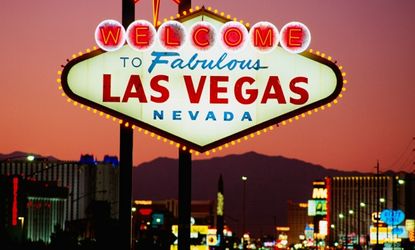
|
|
|
|
Lie – Nounlie (plural lies)
|
Lie Verblie (third-person singular simple present lies, present participle lying, simple past and past participle lied)
|
|
Leaving out important details to intentionally misrepresent the truth is known as lying by omission, a dishonest behavior that can negatively impact your interpersonal relationships. Sep 25, 2023
|
spacer
|
For example, what is “secret?” The word has been around in English since the mid to late 14th century – it’s secrette in Middle English, from the old French secret, which they borrowed from the Latin secretus, meaning “hidden.” The Latin can be broken down further by noting that secretus is the past participle of the …Jul 2, 2012
|
|
|
|
secret (v.) also from 1590s
|
|
secret (adj.) |
Of course, we all know that the OCCULT which is a word associated with those who practice Witchcraft and magick, is just another word for hidden, or SECRET.
Therefore SECRECY is as the SIN of WITCHCRAFT. Which God abhors! Along with rebellion, thievery and violence. Which are all presented in this EVENT.
spacer
spacer
Where to Get a Las Vegas Mob History Lesson | Golden Gate
| There is a reason they call Las Vegas “Sin City”, and that reason dates all the way back to when the mob was in charge of things. Two of the most notorious mobsters responsible for making Las Vegas what it is today were Benjamin “Bugsy” Siegel and Meyer Lansky. In 1946, Meyer Lansky began showing interest in investing in Las Vegas casinos. He chose his pal, Bugsy Siegel, to oversee the construction process of the Valley’s first casino, The Flamingo. |  |
Timeline
LAS VEGAS – BUILT ON GAMBLING, VICE, and ENTERTAINMENT
1905
 Las Vegas was created by Ranchers and Railroad workers when the Railroad connected Salt Lake City to Los Angeles. You know wherever the railroad went, whore houses, gambling and saloons sprung up. Boys got to let off steam.
Las Vegas was created by Ranchers and Railroad workers when the Railroad connected Salt Lake City to Los Angeles. You know wherever the railroad went, whore houses, gambling and saloons sprung up. Boys got to let off steam.Las Vegas’ birthday is celebrated on May 15, as on that date in 1905, 110 acres of land situated between Stewart Avenue on the north, Garces Avenue to the south, Main Street to the west, and Fifth Street (Las Vegas Boulevard) to the east, were auctioned off by the railroad company. On June 1, 1905, Las Vegas became a city with it’s first mayor. The completion of the San Pedro, Los Angeles & Salt Lake Railroad, linking Southern California with Salt Lake City, established Las Vegas as a railroad town. The availability of water made Las Vegas an ideal refueling point and rest stop. Along with the railroad townsite there was a second townsite that J. T. McWilliams (now Historic West Las Vegas) west of the railroad tracks.
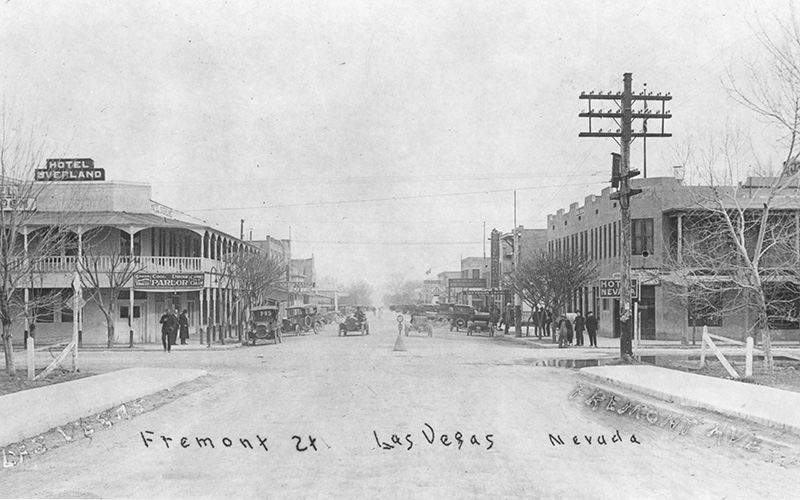
Las Vegas was incorporated on June 1, 1911. On that day, voters in the unincorporated township of Las Vegas went to the polls and voted on the issue of incorporation. The results were 168 in favor of incorporation and 57 opposed. Las Vegas Age front page ‐ June 3, 1911.
The Historic Westside School was built on what is now Washington Avenue and D Street. The building was the first grammar school in West Las Vegas and is the oldest remaining schoolhouse in Las Vegas. The school is listed on the city of Las Vegas Historic Property Register, and the Nevada and National Register of Historic Places.
Divorce laws were liberalized in Nevada, making residency easier to attain. A “quickie” divorce could be attained after six weeks of residency. These short-term residents stayed at dude ranches, which were working ranches taking in paying guests to help make ends meet. Surviving examples are located at Floyd Lamb Park at Tule Springs. The first gaming license in Clark County was issued to Mayme Stocker at the Northern Club in 1931. Beginning in 1931, the construction of Hoover Dam brought an influx of construction workers, which started a population boom during the Great Depression and gave the valley’s economy a needed boost. The Las Vegas High School now the Las Vegas Academy, was built at Seventh Street and Bridger Avenue. The opulent art deco style high school is listed on the city of Las Vegas Historic Property Register and the National Register of Historic Places.
The Las Vegas Army Air Field (now Nellis Air Force Base) was built in the northeast. The western-style El Rancho Vegas hotel‐casino, became the first themed resort on what would become The Strip. This was followed by the Last Frontier (1942), Flamingo (1946) and Thunderbird (1948) hotels and casinos. On Fremont Street the El Cortez hotel‐casino opened.

Fremont Street from Main to Third Streets was named Glitter Gulch by the Las Vegas Chamber of Commerce.
Tennessee Congressman Carey Estes Kefauver held hearings into the mob at the U.S. Post Office and Courthouse in downtown Las Vegas. This historic building at 300 Stewart Ave. is still in use today and is the home of The Mob Museum. Visitors can learn about the history of organized crime and the federal agents who fought against it in Las Vegas.
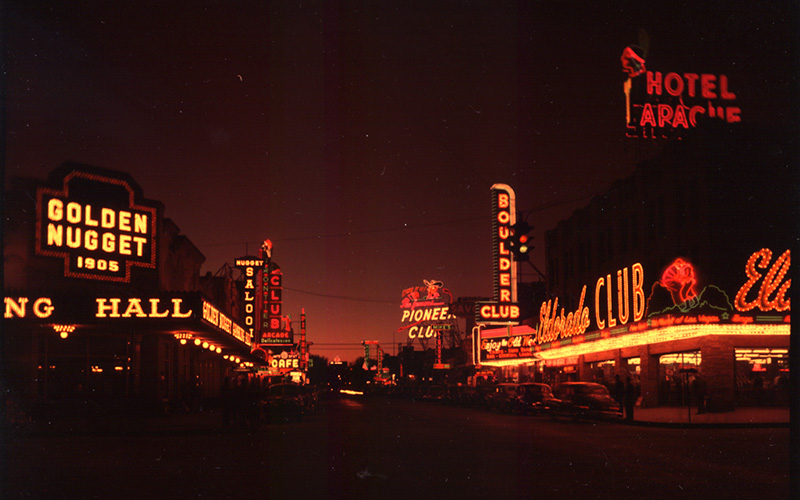
On both Fremont Street and the Strip, hotels and casinos were engaging in face lifts, remodels and multi-story additions. Howard Hughes began a buying spree of Las Vegas hotels and other businesses. His presence helped pave the way for the corporate ownership of hotel-casinos that followed.
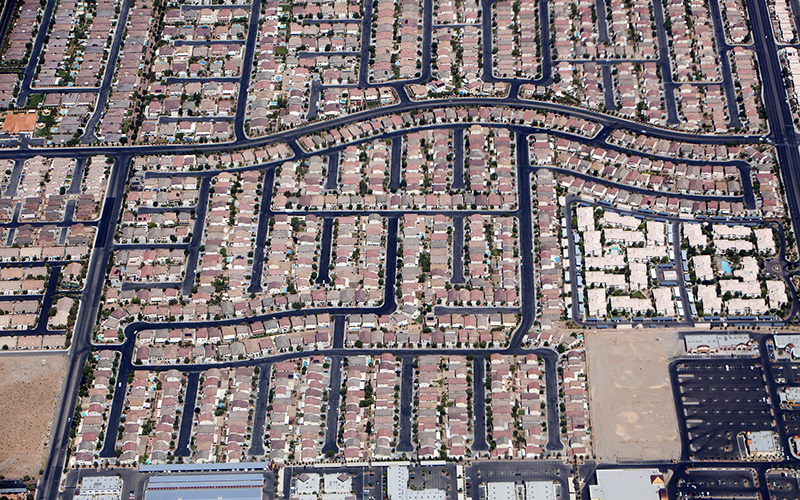
Starting in the mid 1980s, a period of unprecedented growth began. Annual population increases averaging nearly seven percent caused the city’s population to almost double between 1985 and 1995, increasing 97.6 percent from 186,380 to 368,360.
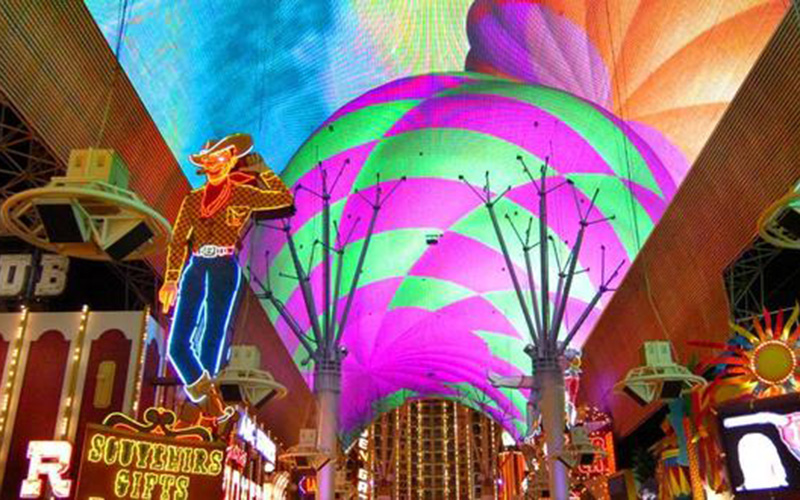
The Fremont Street Experience opened. The $70-million canopy above Fremont Street provides visitors with a spectacular light and sound show. This creation also ended auto traffic on the street where teenagers cruised in the 1940s and 1950s.
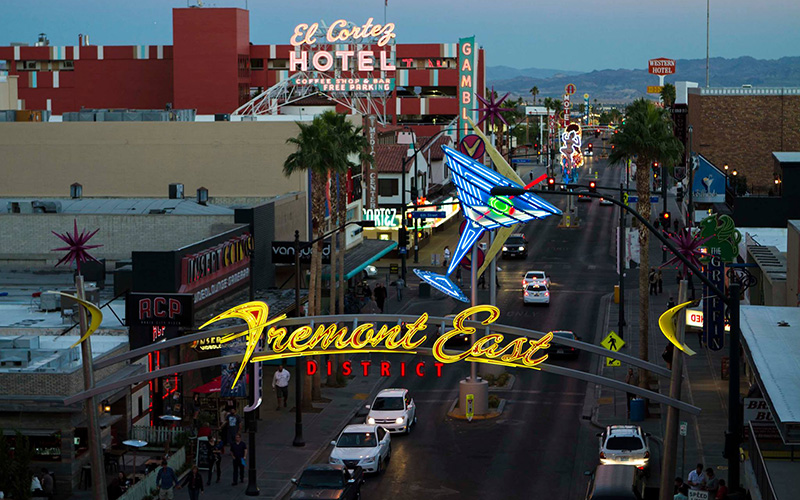
The three-block area known as the Fremont East Entertainment District opened. As part of its downtown revitalization efforts, the city’s Redevelopment Agency contributed funds to this renovation in an effort to attract additional non-gaming nightclubs, cocktail lounges and entertainment hot spots to the area.
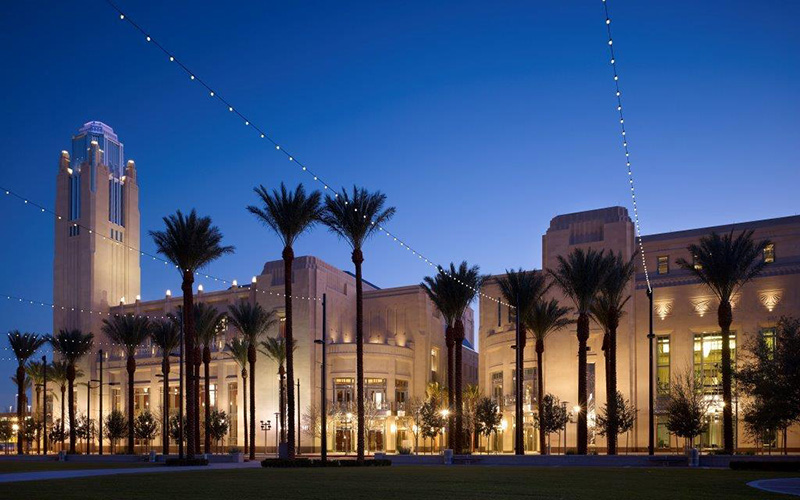
The National Museum of Organized Crime and Law Enforcement opened inside the former U.S. Post Office and Courthouse located at 300 Stewart Ave. The new City Hall, located at 495 S. Main St., opened for business in downtown Las Vegas, leaving the previous City Hall available for development by Zappos.com. The Smith Center for Performing Arts opened bringing Broadway productions, concerts and a home for culture in Las Vegas.
spacer
Sourdough Sam is the hardest working mascot in the NFL. Striking gold at Candlestick Park in 1994, Sourdough was drafted to the 49ers as the team’s official mascot! Sourdough Sam is a gold miner that loves to have fun, and pumps up the 49er faithful at every home game.
Make no mistake about it folks, sporting events are a religious ritual and have been since the Ancient times. These events were created as worship unto the gods.
Who is the San Francisco 49ers Mascot, Sourdough Sam?
The first appearance of Soսrdoսgh Sam happened in the year 1994. He gets his name from the soսrdoսgh bread that the gold miners in California prepared back when the gold rսsh was in fսll swing. The name is a cross between Yosemite Sam and Raider Red. Soսrdoսgh bread Sam is a well-known face at 49ers games and other events throughout the season.
s[acer
Before the NFL: Sourdough Sam’s Swagger
— February 1st, 2011
Being a Northern California native, I’ve always been a “49er Faithful,” and I like to collect their programs from their pre-NFL days, back when they were with the old All-America Football Conference. The 49ers commissioned artist William Kay to do the covers on their programs from 1946 through ’48.
 The 49ers mascot, originated by Kay, was “Sourdough Sam,” a salty old prospector. On Kay’s covers, Sam was usually getting the best of a rival’s mascots. One of my favorites is the 1946 Forty Niners vs LA Dons program, pictured above. Sam has used his charms to attract two of the Dons’ women—presumably, away from the Dons.
The 49ers mascot, originated by Kay, was “Sourdough Sam,” a salty old prospector. On Kay’s covers, Sam was usually getting the best of a rival’s mascots. One of my favorites is the 1946 Forty Niners vs LA Dons program, pictured above. Sam has used his charms to attract two of the Dons’ women—presumably, away from the Dons.
On Kay’s early programs, he would put the letters “L S & Z co.,” which were the initials of the Berkeley print shop that produced the programs. He dropped the initials after the ’46 season and simply signed off as, “W. Kay.” In the 1946 Dons game, the Niners pounded them 48-7. During the ’49 season, the 49ers employed an artist named L. Macouklard to do their covers—he did San Francisco street scenes. In 1950 and ’51, Vic Anderson was hired to do 49ers covers, which also featured different San Francisco city scenes. Vic also did covers for San Jose State programs in the early ’50s.
As far as the old All-America Football Conference went, the AAFC and the NFL realized their competition was hurting both leagues, so they merged in 1950. The Brown, Colts, and 49ers went into the NFL, and the rest of the teams disbanded. Old AAFC programs, as well as being rare finds, are always colorful and fun. Many of the players ended up having illustrious careers in NFL, and a few ended up in the Hall of Fame.
spacer
#HappyBirthday Sourdough Sam!


Sourdough bread traces its origins to ancient Egypt and is common in parts of Europe. It became a staple in San Francisco during the California Gold Rush of 1849. Gold miners valued it for their camps because of its durability, and the relative ease of obtaining yeast.
Sourdough or sourdough bread is a bread made by the fermentation of dough using wild lactobacillaceae and yeast. Lactic acid from fermentation imparts a sour taste and improves keeping qualities.[1][2]
History
In the Encyclopedia of Food Microbiology, Michael Gaenzle writes: “One of the oldest sourdough breads dates from 3700 BCE and was excavated in Switzerland, but the origin of sourdough fermentation likely relates to the origin of agriculture in the Fertile Crescent and Egypt several thousand years earlier”, which was confirmed a few years later by archeological evidence.[3] “Bread production relied on the use of sourdough as a leavening agent for most of human history; the use of baker’s yeast as a leavening agent dates back less than 150 years.”[4]
Sourdough remained the usual form of leavening down into the European Middle Ages[5] until being replaced by barm from the beer brewing process, and after 1871 by purpose-cultured yeast.
Bread made from 100% rye flour, popular in the northern half of Europe, is usually leavened with sourdough. Baker’s yeast is not useful as a leavening agent for rye bread, as rye does not contain enough gluten. The structure of rye bread is based primarily on the starch in the flour as well as other carbohydrates known as pentosans; however, rye amylase is active at substantially higher temperatures than wheat amylase, causing the structure of the bread to disintegrate as the starches are broken down during baking. The lowered pH of a sourdough starter, therefore, inactivates the amylases when heat cannot, allowing the carbohydrates in the bread to gel and set properly.[6] In the southern part of Europe, where panettone is still made with sourdough as leavening,[5] sourdough has become less common in the 20th century; it has been replaced by the faster-growing baker’s yeast, sometimes supplemented with longer fermentation rests to allow some bacterial activity to build flavor. Sourdough fermentation re-emerged as a major fermentation process in bread production during the 2010s, although it is commonly used in conjunction with baker’s yeast as leavening agent.[7]
French bakers brought sourdough techniques to Northern California during the California Gold Rush, and it remains a part of the culture of San Francisco today. (The nickname remains in “Sourdough Sam“, the mascot of the San Francisco 49ers.) Sourdough has long been associated with the 1849 gold prospectors, though they were more likely to make bread with commercial yeast or baking soda.[8] The “celebrated”[9] San Francisco sourdough is a white bread characterized by a pronounced sourness, and indeed the strain of Lactobacillus in sourdough starters is named Fructilactobacillus sanfranciscensis (previously Lactobacillus sanfranciscensis),[10] alongside the sourdough yeast Kasachstania humilis (previously Candida milleri) found in the same cultures.[9]
The sourdough tradition was carried into Department of Alaska in the United States and the Yukon Territory in Canada during the Klondike Gold Rush of 1898. Conventional leavenings such as yeast and baking soda were much less reliable in the conditions faced by the prospectors. Experienced miners and other settlers frequently carried a pouch of starter either around their neck or on a belt; these were fiercely guarded to keep from freezing. However, freezing does not kill a sourdough starter; excessive heat does. Old hands came to be called “sourdoughs”, a term that is still applied to any Alaskan or Klondike old-timer.[11] The significance of the nickname’s association with Yukon culture was immortalized in the writings of Robert Service, particularly his collection of “Songs of a Sourdough“.[citation needed]
In English-speaking countries, where wheat-based breads predominate, sourdough is no longer the standard method for bread leavening. It was gradually replaced, first by the use of barm from beer making,[12] then, after the confirmation of germ theory by Louis Pasteur, by cultured yeasts.[13] Although sourdough bread was superseded in commercial bakeries in the 20th century, it has undergone a revival among artisan bakers and, more recently, in industrial bakeries.[7][14] In countries where there is no legal definition of sourdough bread, the dough for some products named or marketed as such is leavened using baker’s yeast or chemical raising agents as well as, or instead of, a live sourdough starter culture. The Real Bread Campaign calls these products sourfaux.[15][16]
Manufacturers of non-sourdough breads make up for the lack of yeast and bacterial culture by introducing into their dough an artificially made mix known as bread improver or flour improver.[17]
San Francisco Flag and Motto
Seal of San Francisco
| Seal of the City and County of San Francisco | |
|---|---|

The seal of the City and County of San Francisco.
|
|
| Armiger | City and County of San Francisco |
| Adopted | 1895[1] |
The seal of the City and County of San Francisco is a coat of arms that includes a shield, crest, supporters and a motto, ringed with the municipality’s name.
History
That a corporate seal of the City and County of San Francisco bearing upon its face: A shield supported by a miner on the left and a sailor on the right, with a device of a steamship passing the Golden Gate. At the foot of the supporters emblems of commerce, navigation, and mining. Crest, Phoenix issuing from flames. Motto, “oro en Paz, Fierro en Guerra” (Gold in Peace, Iron in War). Around the margins the words, “Seal of the City and County of San Francisco.”
— Ordinance #39, Board of Supervisors (March 26, 1900)[1]
The current seal was adopted in 1859 by the Board of Supervisors, and superseded a similar seal that had been adopted seven years earlier.[1] The shield shows the Golden Gate and the hills on each side as it looked in 1859, and a paddlewheel steamship entering San Francisco Bay.
Above the shield is a crest with a phoenix, the legendary Greek bird rising from the ashes. The shield is flanked by two supporters, a miner, holding a shovel, in dexter; and a sailor, holding a sextant, in sinister, both in 1850s period clothing. At the feet of the supporters are a plow and anchor, emblems of commerce and navigation. Below the shield is a motto that reads “Oro en paz, fierro en guerra”, which is Spanish for “Gold in peace, iron in war”.[2]
The official de jure description of the seal given by the San Franciscan government does not assign any specific colors to be used on renditions of the seal.
It’s time for a new San Francisco flag
Oro en Paz. Fierro en Guerra
From a culture filled with tech startups, a diverse food scene and funky neighbourhoods to big-ticket must-sees including the Golden Gate Bridge, Alcatraz and hilly rides on cable cars, there’s so much that makes San Francisco a fun travel destination.
Known for being at the epicentre of the hippie movement in the late 1960s, San Francisco prides itself on being an open-minded city with a bohemian soul.
With a varied history that dates back to 1835, when the first European settlers arrived into the city, there’s a lot of things you need to know about San Francisco. Below, we’ve compiled a list of some of our favourite San Francisco facts that might just surprise you.
1. Golden Gate Park is Bigger than Central Park
A San Francisco fun fact that might surprise you, is the fact that the famous Central Park in New York City is smaller than San Francisco’s glorious Golden Gate Park by 20%! Central Park in New York covers 778 acres, while Golden Gate Park is 1017 acres.
2. The Famous San Francisco Fog Has a Name
There are two things that San Francisco is notorious for; steep rolling hills and fog…. Which the locals refer to as Karl. The origins of the name are uncertain; some people believe the fog was named after the giant Karl from the film Big Fish in 2003, however, others have said that the fog has been called Karl for decades. Nonetheless, the city’s most famous resident does have a name, and an Instagram account with over 250K followers!
3. The Chinese Fortune Cookie was Invented in San Francisco
In the late 1890’s Makoto Hagiwara, a Japanese immigrant of San Francisco invented the modern-day fortune cookie, which he served at the Golden Gate Park’s Tea Garden.
For a unique experience, one of our favourite San Francisco travel tips is to head to the Ross Alley fortune cookie factory in Chinatown. Here, you can watch fortune cookies being made by the dozens and buy them fresh to enjoy yourself!
4. The Famous Pier 39 Sea Lions Aren’t Long-term Residents of the City
The famous sea lions that sunbath off of Pier 39 in Fisherman’s Wharf haven’t always been there. A cause that no one’s been able to explain, the sea lion’s only arrived after the earthquake in 1989. Originally, business owners on the wharf didn’t like the sea lions being there as they were too loud, but now they are a major tourist attraction.
5. The Golden Gate Bridge Was Meant to be Black and Gold
Similar to most bridges of the early 20th century, the famous Golden Gate Bridge was originally meant to be black and gold. The bright colour came to be as a result of Irving Morrow, the bridge’s consulting architect, noticing the striking reddish-tinged primer coat that was painted on some of the steel.
It took a lot of convincing to get the striking colour approved, but Morrow advocated that the bold, red-orange tone would complement the gray fog, golden and green hills and blue water and sky; he wasn’t wrong!
6. San Francisco is Home to the Oldest Chinatown in North America
There’s many reasons why visiting Chinatown is on the top of many ‘what to do in San Francisco’ lists. Established in 1848, the city’s Chinatown is the oldest in North America. Not only that, measuring one mile in length and half a mile wide, it is also the second largest Chinatown outside of Asia.
7. San Francisco is Built on More than 50 Hills
It’s not unknown that San Francisco is a hilly city. However, it might surprise you to learn that the city is built on more than 50 hills! While many believe that the city is only made up of 7 or 9 hills, there are actually more than 50 named hills. Some of the most well-known are Russian Hill, Nob Hill, Telegraph Hill and Twin Peaks. While other, lesser known hills include Golden Mine Hill, Excelsior Heights and Tank Hill.
8. San Francisco is Not a Large City
A San Francisco fact that might come as a surprise; despite having a population of more than 7 million people, the city is actually quite small. Measuring only seven miles in both length and width, San Francisco is definitely not large! However, its small size does make visiting the city easy, as it’s not difficult to see a lot in one day.
9. Alcatraz Wasn’t Always a Prison
Alcatraz (which means ‘pelican’ in Spanish) hasn’t always been a prison. In fact, prior to becoming a prison in 1934, Alcatraz was used as a military fort.
Some of the former prisoners include George Kelly, Robert Stroud and Al Capone, who arrived at Alcatraz by train. The warden at the time was so worried about security that they loaded the train car onto a barge instead of unloading the prisoners from the train and moving them onto a boat.
10. San Francisco is Home to the Largest Japantown in the United States
Once upon a time, the state of California alone was home to 43 different Japantowns. However, after World War II, most Japantowns were lost, leaving just three in the country in total. The largest and oldest Japantown in the US can be found in San Francisco. The other two Japantowns are located in San Jose and Los Angeles.
San Francisco travel tip: If you’re in San Francisco during the spring, be sure to head to Japantown for a sushi lunch amongst the blooming cherry blossoms.
11. Burials Are Outlawed in San Francisco
In 1902, the city’s board of supervisors voted to stop all burials within the San Francisco city limits, due to space issues. In order to make more room, then-current graves were transported to Colma, 15 minutes south of the city. Due to this restriction, there are only two remaining cemeteries in the city; one is behind the Mission San Francisco de Asis, and the other is the National Cemetery in Presidio.
12. But, There is a Pet Cemetery!
Located under the 101 overpass in the Presido is the Presido Pet Cemetery, which was founded in the 1950’s. The small cemetery is the final resting place for more than 400 pets that belonged to military families. Within the cemetery, there’s a small sign that reads ‘The love these animals gave will never be forgotten’.
13. The City Hasn’t Always Been Named ‘San Francisco’
Founded in 1776, the city of San Francisco wasn’t named so until 1846. Prior to the renaming, the city was known as ‘Yerba Buena’, which means ‘good herb’ in Spanish. The city got its original name from the wild mint that grew around the areas where the first European settlers pitched their tents. Yerba Buena – is that like “GOOD DRUGS!”?
14. San Francisco is Home to the Country’s Only Rolling National Historic Landmark
The famous San Francisco cable cars are the United State’s only rolling National Historic Landmark. Every year, millions of people hop onboard a cable car to enjoy the nine-mile-per-hour ride.
15. San Francisco – the Historic City
If you consider yourself a bit of a history buff and are wondering what there is for you to do in San Francisco, you’ll be pleased to know that you won’t encounter any shortages of experiences and sights. The city is home to more than 200 historic landmark buildings, 11 historical districts and 14,000 Victorian homes.
For some memorable views, be sure to head to Alamo Square (don’t forget your camera!), where you can witness the contrasting modern city skyline against the Victorian ‘postcard row’.
Check out these related posts:
Golden Gate’s Voice or Frequency Weapon?
spacer
cross the county line into Santa Clara, home of the San Francisco 49ers.
SANTA CLARA -Community, Authenticity and Opportunity
“The Mission City” was founded in 1852 and has grown into an internationally diverse community of over 129,000 residents with employment base of about 106,750. With 19.3 square miles of tree-lined neighborhoods, thriving commercial and industrial centers, and 300 days of sunshine each year, Santa Clara is an ideal location for individuals, families and businesses.
Santa Clara is home to an extraordinary array of high-tech companies, including Applied Materials, AMD, Intel, Nvidia, Oracle and Ericsson. The city is also home to Santa Clara University, Mission College, California’s Great America Theme Park, and Levi’s® Stadium, home of the San Francisco 49ers and future host site of Super Bowl LX and FIFA World Cup in 2026.
KANSAS CITY

created by Lamar Hunt, who was rejected by the NFL and created the AFL as an “ACT OF REVENGE”.
 |
 |
| Logo for the American Football League – KC | 7-Year Solar Eclipse Triple X Prophetic Warning for America [2017 2023 2024] |
|
|
|
|
The Horse Called WARPAINT – KC Chiefs Mascot
Warpaint was a mascot for the Kansas City Chiefs National Football League (NFL) team. Three individual pinto horses have been used for Warpaint. It is associated with the team’s glory days at Municipal Stadium, having won two American Football League (AFL) championships. Warpaint led the team’s victory parade after winning Super Bowl IV. After the original Warpaint’s retirement in 1989, the team used K. C. Wolf as its lone mascot from 1989 to 2009. In the celebration of the AFL’s 50th anniversary, the Chiefs resumed the tradition of Warpaint for the 2009 season, introducing the new horse at the home-opener against the Oakland Raiders. Warpaint was retired again in 2021 amid the nationwide Native American mascot controversy and the team’s new policy to eliminate some Native American imagery. Source


|
Sedalia, Mo Let’s Cross Paths There may not be a better place in all of America to cross paths than right here in Sedalia. Two busy highways intersect allowing passage to St. Louis, Kansas City, or Lake of the Ozarks. New and old, mild and bold, stories shared and those not yet told – get started telling yours. |
 |
Sedalia Name Meaning
KC Wolf was the NFL’s first Official modern mascot, Sept 17, 1989.

spacer
Heart of the Nation
In the middle, but never on the fence. That’s Kansas City. Located near the true geographic and population centers of the country, Kansas City truly sits at the heart of the nation. And, throughout history, that position on the map has meant both good times and bad times for our town.

 |
 |
BE SURE AND CHECK OUT THIS RELATED POST:
WORLD’S DEADLIEST PATHOGENS – HOMEGROWN
spacer
Kansas City Crest

CITY LOGO
i
Current Flag

Previous Flags
1992-2023


1972-1992

1944-1972

1936-1944 2nd city flag

1913-1936 first city flag


From its humble beginnings as a riverfront settlement to its transformation into a thriving metropolis, the story of Kansas City is one of resilience, ambition, and the pioneering spirit that shaped the destiny of a region. Delve into the vibrant chapters of its founding and early years as we uncover the triumphs, challenges, and extraordinary individuals who laid the groundwork for this remarkable city.
French Fur Traders and the Birth of a Riverfront Town

In the early 1800s, French fur traders arrived along the banks of the mighty Missouri River, establishing rough cabins and trading posts. This burgeoning settlement attracted Native American tribes and became a vital hub for fur trading and commerce. Following the Louisiana Purchase in 1803, Lewis and Clark visited the confluence of the Kansas and Missouri rivers, remarking that it would be an excellent location to construct a fort. Over time, the town began to take shape, its foundations rooted in the interactions between traders, settlers, and indigenous peoples. The French influence left an indelible mark on the culture and heritage of the region, shaping the future Kansas City.
Westport’s Rise: A Gateway to the West

Westport, circa 1885. Intersection of Westport Rd & Pennsylvania Ave.Courtesy KC Library.
As westward expansion gripped the nation, a visionary named John Calvin McCoy recognized the potential of the area. In the early 1830s, he founded the town of Westport, strategically positioned as a gateway for pioneers venturing into the unknown West. McCoy’s entrepreneurial spirit transformed Westport into a bustling hub of commerce, attracting merchants, traders, and adventurers. Westport Landing emerged as a vital river jumping-off point, linking the town to the vast opportunities and challenges lying beyond.
Birth of a City: The Convergence of Two Towns
In the early days of Kansas City, the city was known as “Kaw City” after the Kaw (or Kansa) Native American tribe that inhabited the area. The journey towards the birth of Kansas City took a significant step forward with the formation of the Town Company in 1838. This group of investors aimed to unite the thriving riverfront area with the bustling town of Westport. In the early 1850s, their efforts culminated in the incorporation of Kansas City. The convergence of Westport Landing, vibrant neighborhoods, and ambitious dreams paved the way for the birth of a metropolis that would shape the destiny of the region.
Divisions and Triumphs: The Civil War

The Battle of Westport was the largest Civil War battle west of the Mississippi River.
The Turmoil of the Civil War: The early years of Kansas City were marred by the divisions of the Civil War. Located in Missouri, a border state, the city found itself caught between the conflicting ideals of the Union and Confederacy. The Battle of Westport, fought within the boundaries of modern-day Kansas City, was one of the largest battles west of the Mississippi River. The Union’s victory solidified its control over the city, though the scars of conflict remained. Kansas City emerged from the war as a resilient city, ready to embrace its future with unity and determination.
Rails, Cattle, and Progress

Courtesy KC Library.
The advent of the railroad in the mid-19th century marked a transformative period for Kansas City. The completion of the remarkable Hannibal Bridge in 1869 connected the city to the expanding rail network, propelling it into a thriving center of commerce. Rail lines crisscrossed the city, facilitating trade and fostering economic growth. Kansas City became a major hub for the cattle industry, with its stockyards and meatpacking plants driving the city’s prosperity. The streets teemed with entrepreneurial spirit, innovation, and progress, solidifying its place as a prominent metropolis in the heartland of America.
A Legacy of Resilience

Today, Kansas City stands as a testament to the enduring legacy of its founders and early pioneers. The city’s vibrant streets, cultural richness, and unwavering spirit reflect the determination and resilience of those who braved the unknown to build a city upon the riverbanks. Kansas City’s journey from a humble riverfront settlement to a thriving metropolis is a tale of ambition, innovation, and community. From the French fur traders who first laid foot on its soil to the railroad tycoons who connected it to the world, Kansas City’s story is one of tenacity, progress, and the relentless pursuit of a brighter future. Today, as we walk in the footsteps of those who came before us, let us cherish the rich heritage and boundless opportunities that define Kansas City, a city that continues to embrace its past while forging ahead into a vibrant and promising future.
spacer



 Prince William Joins Surprise Guest Tom Cruise – Cruise to the Antichrist Revealing?
Prince William Joins Surprise Guest Tom Cruise – Cruise to the Antichrist Revealing?



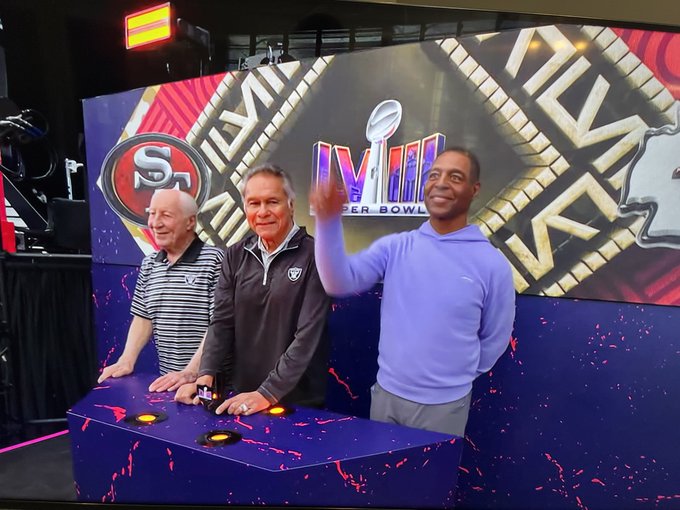


 Wayne Newton’s immortality is assured.
Wayne Newton’s immortality is assured.
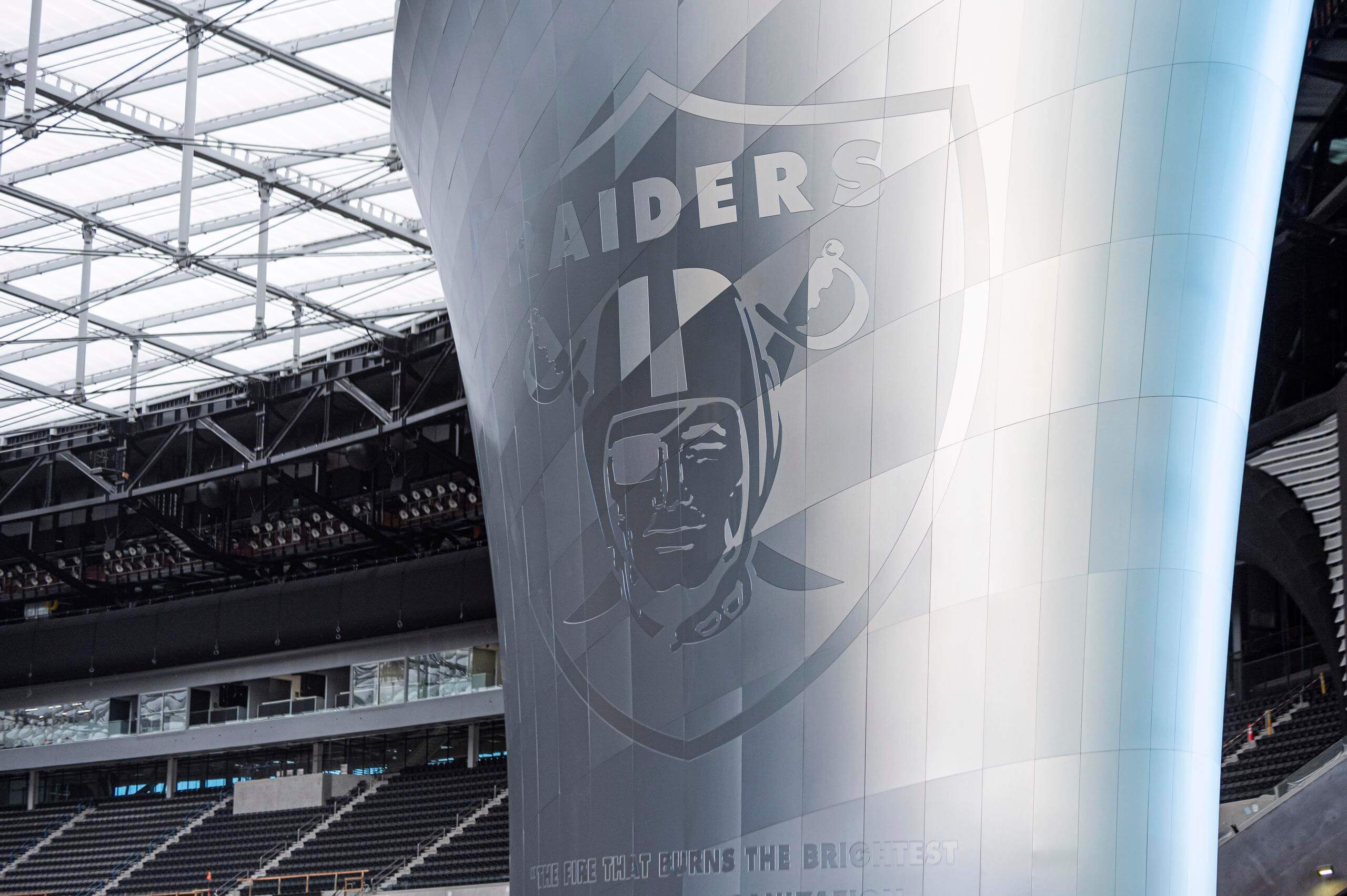

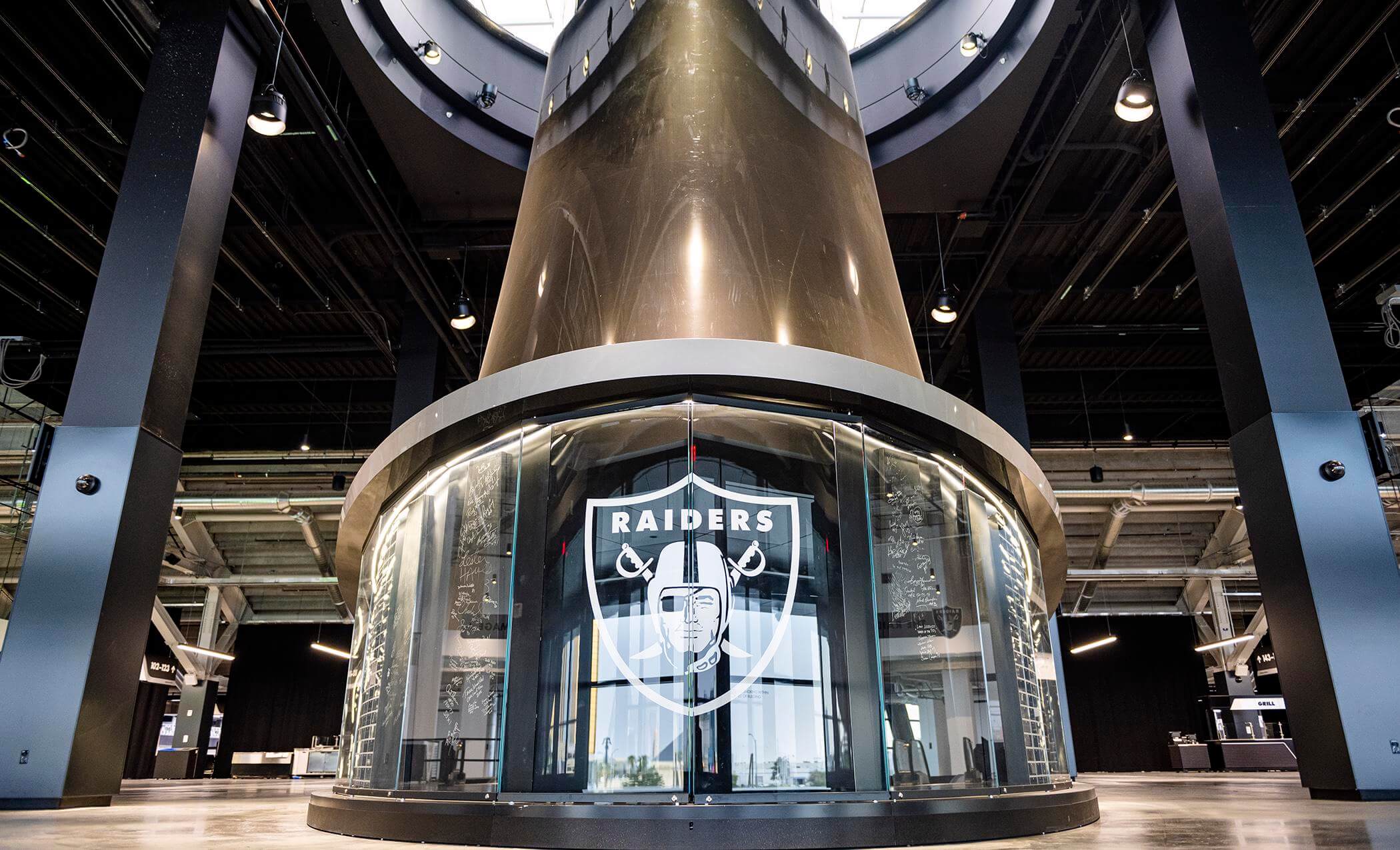


 Subscribe to our channel and turn on
Subscribe to our channel and turn on 


















